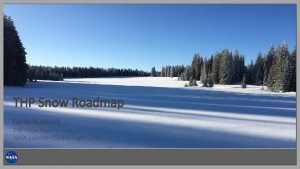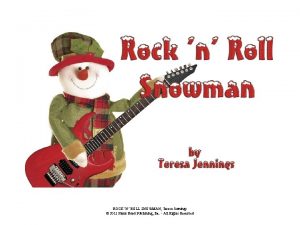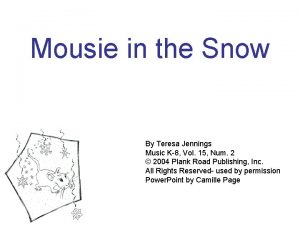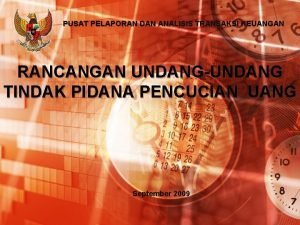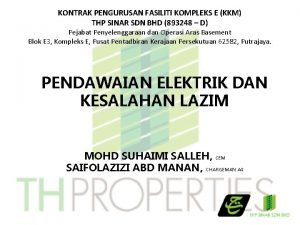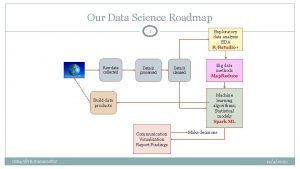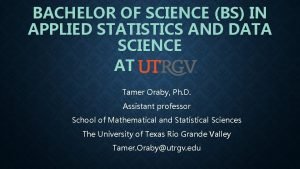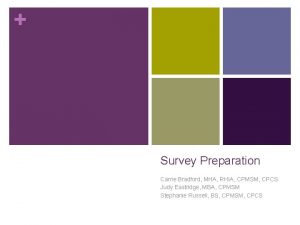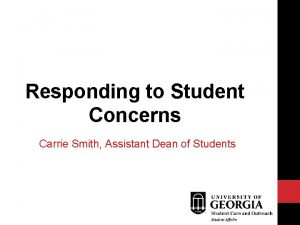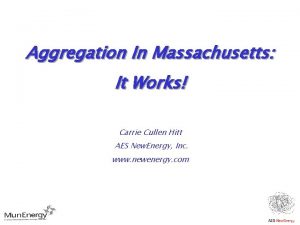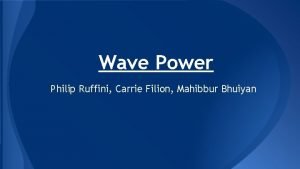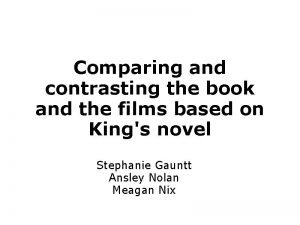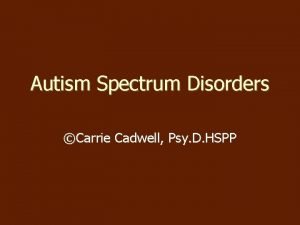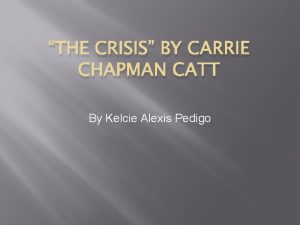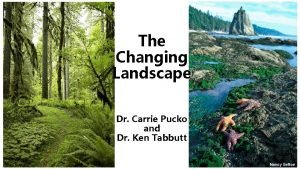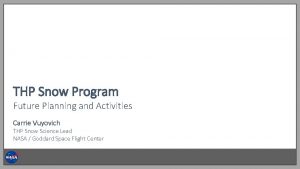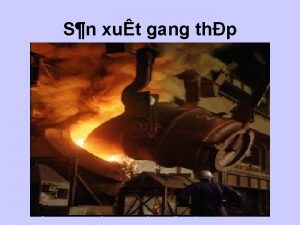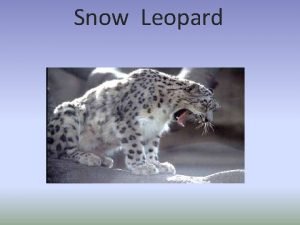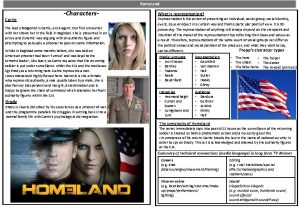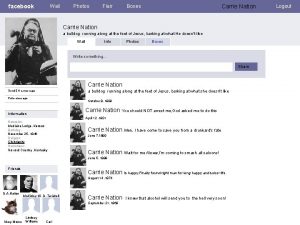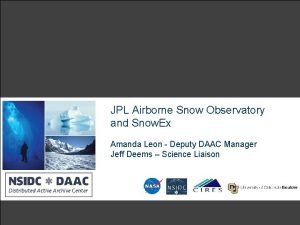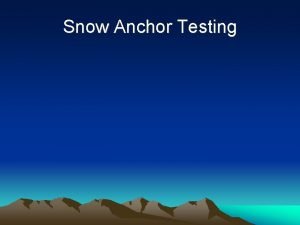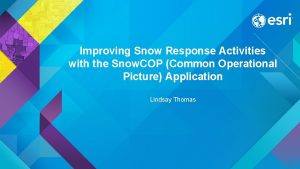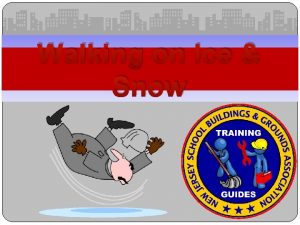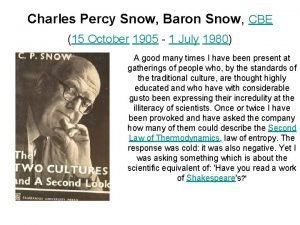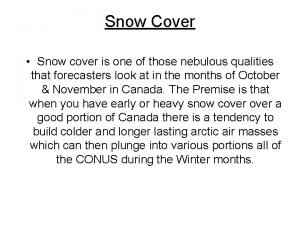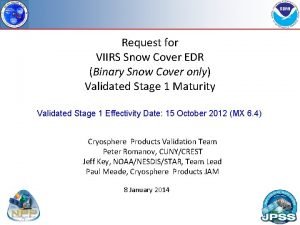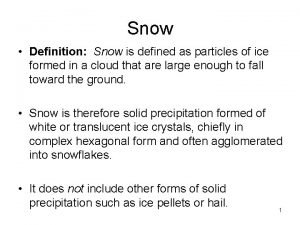THP Snow Roadmap Carrie Vuyovich THP Snow Science




















- Slides: 20

THP Snow Roadmap Carrie Vuyovich THP Snow Science Lead NASA / Goddard Space Flight Center

THP Snow Roadmap 2

THP Snow Program Science Goal: To characterize the temporal and spatial variation in Earth’s terrestrial snow; to quantify the snow energy and mass balances; to understand the role of snow in the Earth’s climate, water, and carbon cycles. Application Goal: Improve snow and snowmelt estimation capabilities for water supply, agriculture, energy and hazard (flood, drought, avalanche) forecasting. THP Snow Roadmap: A near- to medium-term plan for future activities designed to prepare the snow community to be ready for upcoming opportunities, improve global snow characterization capabilities and meet identified snow data needs in order to achieve the overall Science and Application Goals. 3

Timeline driven by upcoming satellite missions and opportunities Potential opportunities for spaceborne snow observations: • • • Earth Venture Mission NISAR – L-band In. SAR TSMM – Ku-band SAR SBG – Hyperspectral Earth System Explorer (ESE) – Identify possible satellite technologies that meet mission criteria – Define activities required to evaluate potential concepts New techniques and advances are being demonstrated with existing satellites: • • • C-band SAR - Sentinel-1 Stereo-photogrammetry – Worldview, Planet, Pleiades Spaceborne lidar – ICESat-2, GEDI 4

Roadmap Goals Longer-term Goals: • Global Snow System: Framework capable of aggregating datasets; assessing the accuracy; and informing analyses • Global snow climatology & uncertainty characterization Mid-term Goals: • Trade study analysis of mission designs and configurations • OSSE over large domain to evaluate • Value of individual and multiple observations • Value to applications • Cal/Val sites established • Multi-sensor demonstration campaign Near-term Goals: • Baseline assessment of current RS and modeling capabilities • Field validation & algorithm development of RS techniques for potential missions • OSSE over regional domain to test value of snow retrievals • Define snow data requirements 5

Roadmap Objectives Specific Activities and Needs: Modeling: Demonstrated global snow capability with combined multisensor, model approach; pathway from research to operations • Model parameterizations and uncertainty • Data Integration: OSSEs/Trade Studies • Global snow system Algorithm Development: Quantify uncertainty in SWE, snow depth and albedo retrievals in different snow classes and for different snow properties • L-Band In. SAR • Microwave • Lidar/Stereo Technology Development: Increased TRL for snow remote sensing sensors and technologies • Data Access/Computing • Sensor Development • Innovations Science & Applications: Improved understanding & representation of snow processes in models, impact on remote sensing signals • Snow/vegetation interactions • Snow/substrate interactions • Infiltration and runoff processes Field Campaigns & ground validation: Global maps of uncertainty and thresholds for snow estimation techniques • Snow. Ex Campaigns • Calibration/Validation sites • Multi-sensor demonstration campaign Community Engagement: Train and engage snow community to participate in field, modeling, technology development and data analysis activities • Snow Schools & Hackweeks • Community Meetings • Proposal Opportunities • Hyperspectral • C-Band SAR • So. OP 6

Breakout Group: Modeling/SEUP Recent work: characterization of uncertainty of SWE from LSMs over North America; implementation of new snow models into LIS (Crocus and Snow. Model); calibration for OSSE Nature Run Discussion points: • How can model estimates inform field campaigns (observation type, timing, location, etc)? • What type of field observations are needed for improving model representation/characterizing model uncertainty? • What type of real time modeling would be useful for upcoming campaigns? • Potential review papers on state of the science for snow modeling – redistribution, snow grain size, etc Rhae Sung Kim, rhaesung. kim@nasa. gov Melissa Wrzesien, melissa. l. wrzesien@nasa. gov

Breakout Group - Microwave Snow A. X- and Ku- band volume scattering based approach for SWE retrieval – Snow. SAR (9. 6 GHz, 17. 2 GHz ), SWESARR (9. 6 GHz, 13. 4 GHz, 17. 2 GHz), UMass Ku Band (13. 4 GHz ), Airborne and Satellite SAR Processing B. Canada TSMM ( Ku-, 13. 4, 17. 2 GHz) mission; Companion satellite of TSMM: Ku Band Interferometry C. Snow. Ex Ground Measurements and Snow Physical Models D. Using Sentinel 1 C-band (5. 404 GHz) Radar Dataset for 1) snow/soil boundary roughness extraction and 2) Cross-polarization for deep snow retrieval Leung Tsang, leutsang@umich. edu DK Kang, dk. kang@nasa. gov 8

Breakout Group – L-Band In. SAR Eli Deeb, Elias. J. Deeb@erdc. dren. mil Jewell Lund, lund. jewell@gmail. com 9

Breakout Group – L-Band In. SAR • Physical properties that impact coherence – Changes between acquisitions: soil conditions, snow wetness, accumulation greater than phase ambiguity, extreme snow microstructure contrast • • • Performance in steep terrain Frequency dependent phase ambiguity Vegetation interaction Snow wetness Results: – Snow. Ex 2017 – Snow. Ex 2020 Eli Deeb, Elias. J. Deeb@erdc. dren. mil Jewell Lund, lund. jewell@gmail. com

Breakout Group - Lidar/stereo WG • Purpose: • Assess lidar, stereo and combined lidar+stereo technology for snow (airborne campaigns and future satellite missions) • Recent focus: • Continued assessment of currently available on-orbit satellite resources for snow • Lidar: ICESat-2, GEDI • VHR Stereo: World. View, Sky. Sat, Pleiades • Considering airborne options for 2021 and 2022 campaigns • Discussion topics: • Value of combined lidar+stereo • Surface Topography and Vegetation (STV) Mission workshop • Airborne campaigns - experiment campaigns, balancing operational snow science vs. tests for future missions • Uncertainty for different environments • Gaps in understanding: • Stereo geometry, number of looks, • Resolving power for individual trees, gaps between trees David Shean, dshean@uw. edu Nancy Glenn, nancyglenn@boisestate. edu 11

Breakout Group - Taiga/Tundra Snow Albedo • What do we need to know in order to enhance snow evolution models and representation of Taiga/Tundra snow albedo in land surface models? – Change in albedo over time, space, scales – and uncertainties – Albedo decay functions or other parameterizations • What do we need to measure? – – – Spectral albedo – spectral range? precision? accuracy? Snow albedo across forest density and woody shrub-tundra gradients Light absorbing impurities – forest litter, charred woody debris, BC, dust Solar irradiance at snowpack surface – accumulation and ablation periods Forest and topographic characteristics from tree to forest scales (incl. shading), mtn. to flats Angular characteristics (BRDF) -- flat, mountainous, open, forested terrain • Where do we deploy to accomplish these objectives? – Fairbanks region (Bonanza Creek, Caribou/Poker Flats, Shovel Creek fire) – Toolik? – Other? Anne Nolin, anolin@unr. edu Charles Gatebe, charles. k. gatebe@nasa. gov

Breakout Group - Science & Applications Possible Topics for Discussion: • Who is currently using remote sensing of snow data? • Who would we like to target in the future? • • – What are the current methods they use? What is the spatial/temporal resolution “sweet spot”? What are the major hurdles in this area? What can other communities tell us? How can field campaigns help improve our understanding of snow processes? • What is the impact of improved understanding and representation on our ability to inform applications (e. g. streamflow, flood/drought, etc. )? Ryan Webb, rwebb@unm. edu Kate Hale, Katherine. E. Hale@colorado. edu

BACKUP: THP Roadmap Specific Activities 14

Modeling Objective: Demonstrated global snow capability with combined multi-sensor, model approach; pathway from research to operations Specific research areas & needs: • Snow model parameterizations and uncertainty – Advanced snow physics (e. g. microstructure, transport) in Land Surface Models (LSMs) – Uncertainty in forcing data – Subgrid spatial variability • Data Integration – Snow Observation System Simulation Experiments (OSSEs) and Trade Studies to systematically evaluate the impact of different mission designs and choices – Model-based remote sensing downscaling and gap-filling techniques – Data assimilation/merging techniques • Global snow system 15

Algorithm Development Objective: Quantify uncertainty in SWE, snow depth and albedo retrievals in different snow classes and for different snow properties Specific research areas: • L-band In. SAR • Microwave • Spaceborne lidar/stereo • Hyperspectral snow albedo • C-band SAR SWE retrievals • Signal of Opportunities (So. OP) • Multi-frequency retrieval algorithms 16

Technology Development Objective: Increased TRL for snow remote sensing sensors and technologies Specific research areas: • Data Access/Computing • Virtual data access • Cloud and server side computing • Sensor Development & Innovations • SWESARR maintenance and upgrades • So. OP ground-based and airborne validation in different environments • Small-sat/Cube-sat concepts • Multi-instrument airborne platform • Companion/leveraging mission concepts 17

Science & Applications Objective: Improved understanding & representation of snow processes in models, impact on remote sensing signals Specific research areas: • Snow-vegetation interactions • Snow canopy interception • Snow sublimation and role in water balance • Spatial patterns of snow distribution in different environments • Snowmelt infiltration and runoff • Surface roughness impact on snow distribution • Snow-substrate interactions 18

Field Campaigns & ground validation Objective: Global maps of uncertainty and thresholds for snow estimation techniques Activities: • Snow. Ex Campaigns – 2017 – multi-aircraft, forest gradient focus – 2020 – multi-aircraft, various snow climates, time series approach – 2021 – small scale: time series, albedo and prairie focus – 2022 – tundra/taiga focus – 2023 – small scale; TBD • Multi-sensor demonstration campaign • Calibration/Validation long-term sites 19

Community Engagement Objective: Train and engage snow community, in particular early-career snow scientists to participate in field, modeling, technology development and data analysis activities Activities: • Community Meetings • Training – Field schools – Modeling schools – Remote sensing schools • Hackweeks • Proposal opportunities 20
 Carrie vuyovich
Carrie vuyovich Snow snow snow teresa jennings
Snow snow snow teresa jennings Snow by teresa jennings
Snow by teresa jennings Thp ecocardiograma
Thp ecocardiograma Thp ppatk
Thp ppatk Thp sinar sdn bhd
Thp sinar sdn bhd Few snow or little snow
Few snow or little snow Science is my favourite subject
Science is my favourite subject Science roadmap
Science roadmap Utrgv roadmap
Utrgv roadmap Mha carrie
Mha carrie Carrie smith uga
Carrie smith uga Carrie cullen
Carrie cullen Carrie filion
Carrie filion Carrie brookes
Carrie brookes Carrie valdez md
Carrie valdez md Carrie 2002
Carrie 2002 Carrie mae weems biography
Carrie mae weems biography Carrie cadwell
Carrie cadwell Carrie chapman catt the crisis
Carrie chapman catt the crisis Carrie pucko
Carrie pucko
